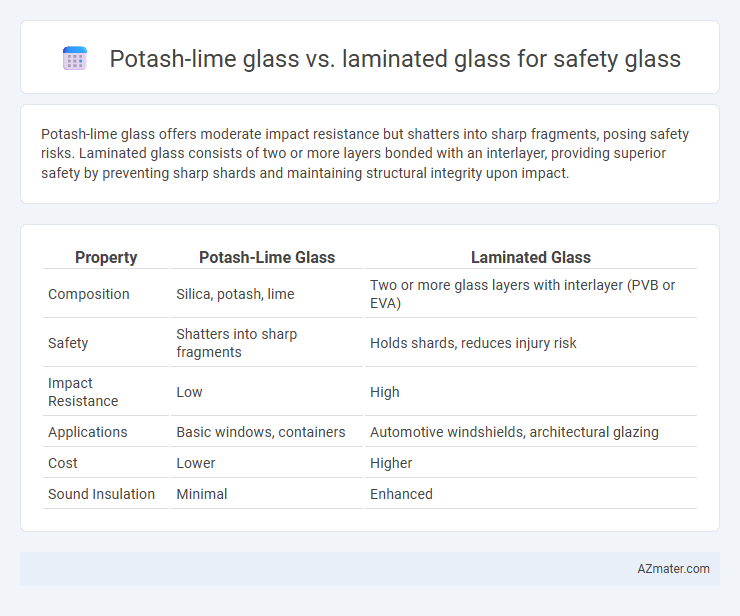Potash-lime glass offers moderate impact resistance but shatters into sharp fragments, posing safety risks. Laminated glass consists of two or more layers bonded with an interlayer, providing superior safety by preventing sharp shards and maintaining structural integrity upon impact.
Table of Comparison
| Property | Potash-Lime Glass | Laminated Glass |
|---|---|---|
| Composition | Silica, potash, lime | Two or more glass layers with interlayer (PVB or EVA) |
| Safety | Shatters into sharp fragments | Holds shards, reduces injury risk |
| Impact Resistance | Low | High |
| Applications | Basic windows, containers | Automotive windshields, architectural glazing |
| Cost | Lower | Higher |
| Sound Insulation | Minimal | Enhanced |
Introduction to Safety Glass Types
Potash-lime glass, commonly used in standard windows, offers basic transparency and strength but lacks advanced safety features, making it less suitable for impact-prone environments. Laminated glass consists of two or more layers of glass bonded with an interlayer, providing superior impact resistance and preventing shattering, which enhances occupant protection. Safety glass types like laminated glass comply with stringent safety regulations due to their ability to hold glass fragments together upon breakage, significantly reducing injury risk.
What is Potash-Lime Glass?
Potash-lime glass is a common type of soda-lime glass that contains potassium oxide, enhancing its chemical durability and resistance to water corrosion compared to traditional sodium-based soda-lime glass. This glass type is widely used in windows, bottles, and light bulbs due to its durability and cost-effectiveness but lacks the built-in safety features of laminated glass. Laminated glass incorporates layers of polyvinyl butyral (PVB) between glass sheets, providing superior impact resistance and preventing shattering, making it preferable for safety glass applications where injury prevention is critical.
What is Laminated Glass?
Laminated glass consists of two or more layers of glass bonded together with an interlayer, typically made of polyvinyl butyral (PVB), which enhances its safety features by preventing shattering upon impact. This construction provides superior resistance to breakage compared to potash-lime glass, making laminated glass ideal for applications requiring high durability and protection, such as automotive windshields and architectural glazing. Potash-lime glass, the most common glass type, lacks this layered interlayer, resulting in a higher risk of fragmentation and injury when broken.
Chemical Composition Comparison
Potash-lime glass primarily consists of silica (SiO2), sodium oxide (Na2O), potassium oxide (K2O), calcium oxide (CaO), and magnesium oxide (MgO), offering moderate chemical resistance and good optical clarity. Laminated glass combines layers of potash-lime or borosilicate glass with an interlayer of polyvinyl butyral (PVB) or ethylene-vinyl acetate (EVA), enhancing impact resistance and preventing shattering by holding fragments together. The chemical composition of laminated glass's polymer interlayer significantly improves safety performance compared to the brittle nature of standard potash-lime glass.
Manufacturing Processes
Potash-lime glass is manufactured by melting silica, potash, and lime at high temperatures, resulting in a less expensive and widely used float glass with moderate impact resistance. Laminated glass consists of two or more layers of glass bonded together with an interlayer, typically polyvinyl butyral (PVB), using heat and pressure to enhance safety by preventing shattering upon impact. The manufacturing process for laminated glass is more complex and costly but provides superior structural integrity and safety compared to potash-lime glass.
Strength and Impact Resistance
Potash-lime glass exhibits moderate strength and impact resistance, making it less suitable for high-safety applications compared to laminated glass. Laminated glass combines multiple layers with an interlayer, significantly enhancing its toughness and ability to absorb impact without shattering. The superior strength and impact resistance of laminated glass make it the preferred choice for safety glass in automotive and architectural uses.
Safety and Shatter Characteristics
Potash-lime glass, commonly used in standard glazing, tends to break into sharp, dangerous shards, posing a higher risk of injury during impact. Laminated glass enhances safety by incorporating a polymer interlayer that holds shards together upon breakage, significantly reducing the chances of injury from sharp fragments. The shatter characteristics of laminated glass ensure improved impact resistance and structural integrity, making it the preferred choice for safety glass applications in automotive, architectural, and security settings.
Common Applications in Safety Contexts
Potash-lime glass is commonly used in standard windowpanes and picture frames due to its cost-effectiveness and moderate impact resistance, while laminated glass is preferred in automotive windshields, skylights, and glass facades for enhanced safety through its ability to hold shards together upon breakage. Laminated glass incorporates a polyvinyl butyral (PVB) interlayer that improves impact absorption, making it ideal for environments requiring protection from forced entry, blast resistance, and personal injury mitigation. Potash-lime glass, though less durable in safety applications, is frequently used where cost and optical clarity are prioritized over high-impact resilience.
Cost and Availability Analysis
Potash-lime glass generally offers lower initial costs and widespread availability compared to laminated glass, making it a cost-effective option for standard safety glass applications. Laminated glass, while more expensive due to its multi-layered structure and PVB interlayer, provides enhanced safety and durability, justifying its higher market price in high-risk environments. Availability of laminated glass can be limited in some regions, whereas potash-lime glass benefits from extensive global supply chains and faster production times.
Conclusion: Choosing the Right Safety Glass
Potash-lime glass offers cost-effective clarity and basic impact resistance but lacks the enhanced strength and shatter containment of laminated glass, which incorporates a durable interlayer to prevent dangerous shards. Laminated glass excels in safety applications requiring high impact resistance, sound insulation, and UV protection, making it the preferred choice for automotive windshields and building facades. Selecting between potash-lime and laminated glass depends on balancing budget constraints with safety priorities, where laminated glass ensures superior protection and longevity.

Infographic: Potash-lime glass vs Laminated glass for Safety glass
 azmater.com
azmater.com